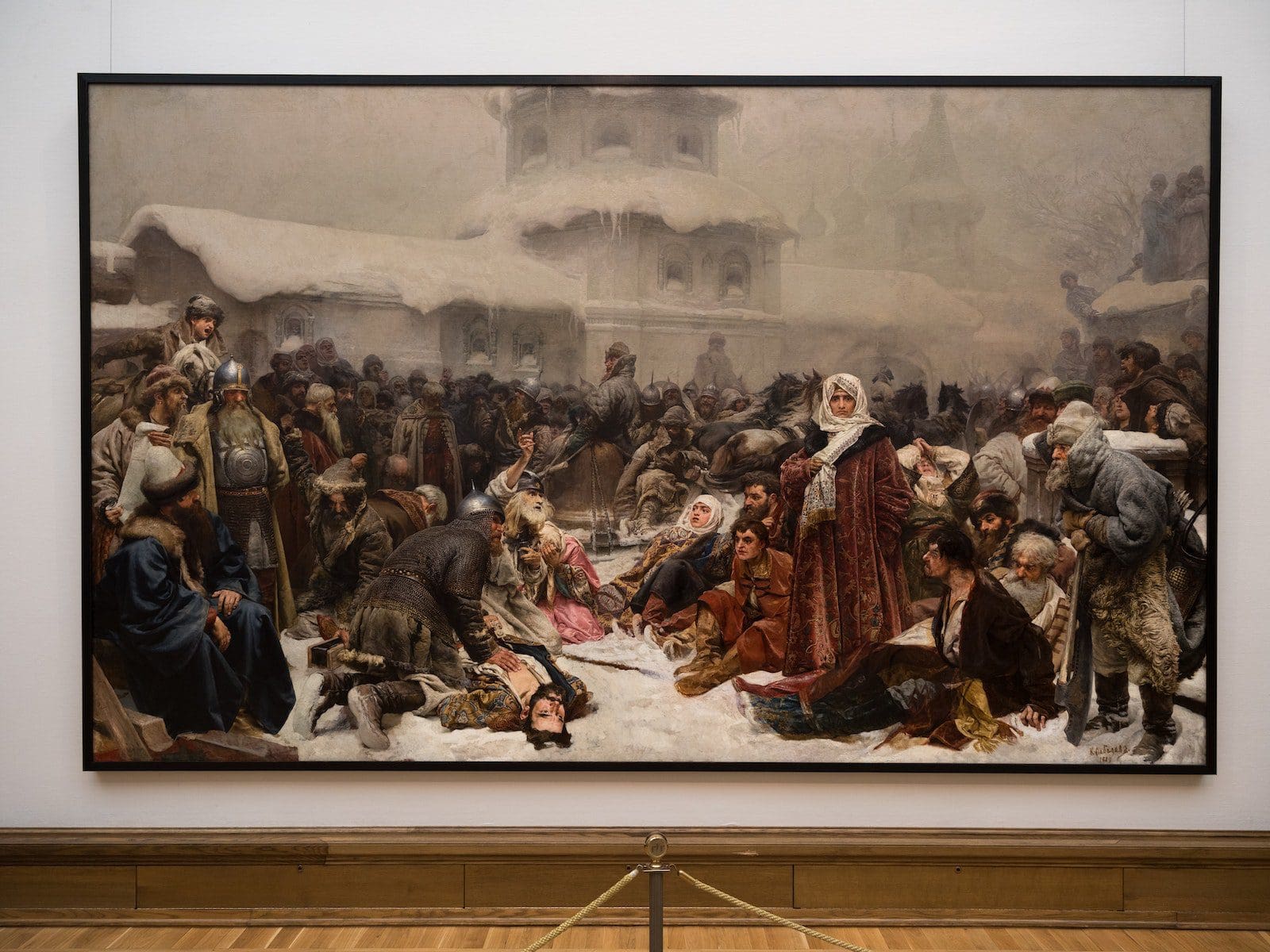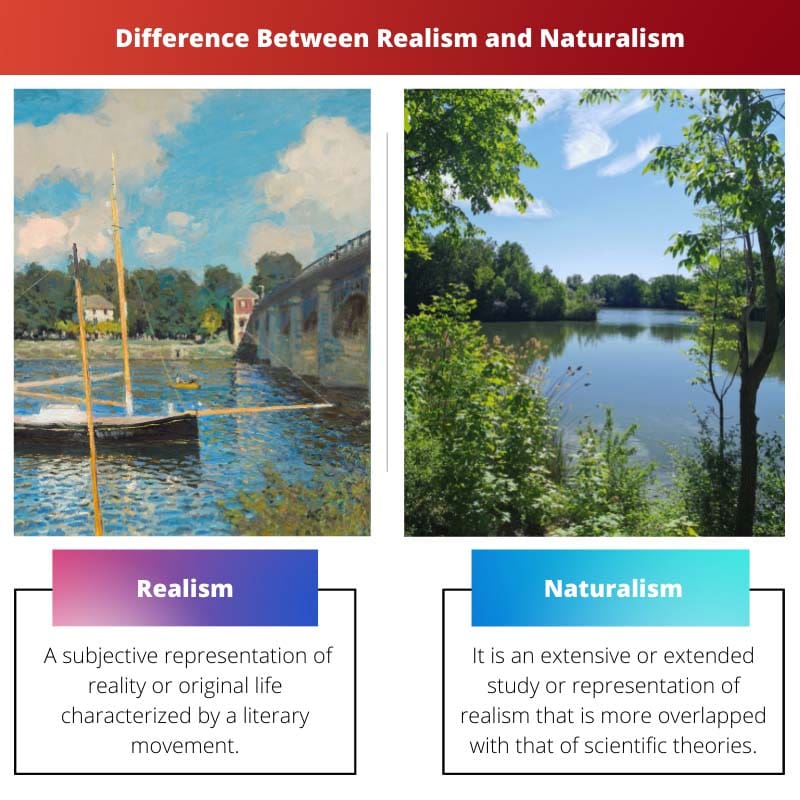Realism and Naturalism are two words that are closely linked to each other.
They are also interchangeable in some scenarios. Realism refers to the view or aspect of visualization which is pre-considered, or its survival is not dependent on what someone has already visualized or perceived.
Naturalism is a method of what the writer or author portrays existence.
Key Takeaways
- Realism emphasizes the accurate representation of everyday life and experiences in art and literature, while naturalism explores the impact of environmental and social forces on human behavior.
- Realism presents an objective and neutral view of the world, whereas naturalism depicts a deterministic perspective influenced by scientific principles.
- Both movements emerged as reactions to romanticism, aiming to portray life more truthfully and objectively.
Realism vs Naturalism
Realism is a literary movement that focuses on the realistic portrayal of everyday life, depicting characters from the middle and lower classes in their ordinary activities. Naturalism takes realism to a more extreme level by presenting a deterministic view of the world, where characters are at the mercy of their environment and circumstances.

Realism refers to the view that reality is something that is pre-considered or perceived by a mind.
This term explains the real objects in the whole wide world that is present as a concept that is for real, and it isn’t just a belief that idealist would make us believe it for reality.
Naturalism is the ideology or subjective conditions that are focused on or determined to improvise the lives of society. It is also distinct to the irresistible character of mankind that could not resist the pre-existing fate.
They are more specific and distinct. It is more of a realistic depiction of the pre-existing species.
Comparison Table
| Parameters of Comparison | Realism | Naturalism |
|---|---|---|
| Meaning | A subjective representation of reality or original life characterized by a literary movement. | It is an extensive or extended study or representation of realism that is more overlapped with that of scientific theories. |
| Portrayal | Realism portrayed life as such. | Naturalism is more dependent on portraying life in association with environmental and biological concepts. |
| Character depiction | Realism depicts middle-class characters. | Naturalism depicts the poor or those below the middle class. |
| Books | Realism is involved in novels that involve themes like society and class. | Naturalism is more fully-fledged through the pieces of literature that involves violence and corruption. |
| Literature focus | It is more focusing on the individual’s perspective. | It is more focusing on those forces that cannot be controlled, such as the biological forces. |
What is Realism?
Realism, as the term itself suggests, exposes the reality present in the lives of individuals.
Realism is an influential literary movement that dominated the arts, literature, and theatre in the 19th century. In simple terms, the era of realism painted a realistic picture of humans and their daily lives through its art forms.
The portrayal of contemporary life was accurate and detailed. Arts in realism were grounded in reality and not fictionalized.
Realism was born out as a counter-movement to the era of Romanticism.
It rejected the Romanticistic ideals of aesthetics, fiction, supernatural elements, and over-idealization of the world. In contrast, the artists of the Realism era depicted lives as it was in their era.
As an aftereffect of the 1848 Revolution in France, the Realism era witnessed the rise in the stories of the common man. Literature moved away from the noble figures and entered the lives of the middle and working classes.
Arts revolved around the common man.
Positivist Philosophy by Auguste Comte influenced Europe to indulge in the scientific and sociological study of society. Professional Journalism, which rose during the same era, did not fail to record the events as they happened.
Intellectual movements like these influenced the artists of the Realism era. The Realism era portrayed a realistic idea of society through various forms of art.

What is Naturalism?
Naturalism was a continuation of Realism. It followed Realistic ideals by including determinism and the methods of natural sciences.
As a literary movement born out of Realism, it holds on to Realistic ideas like the rejection of Romanticism. It was widespread in late 19th-century Europe.
The literary movement Naturalism originated in France and had its roots in the works of Hippolyte Taine. The ideals of Naturalism were spread by Emile Zola’s work “The Experimental Novel.”
Positivist ideas by Comte were the basis of Naturalism and were expounded in Zola’s work. Zola emphasized imparting scientific methods in the literature and conducting controlled experiments with the characters acting as the phenomena.
Naturalism had different factions within it, and authors had divided opinions.
American Naturalism was popular in the American region. This movement was popularized by Frank Norris. He differed from Zola’s view of Naturalism.
Norris viewed Naturalism as Romantic, while Zola was completely opposed and viewed it as truly Realist.
Zola’s Naturalism included the Darwinian view of nature and attempted to infuse scientific methods into literature. Naturalism was certainly popular in late 19th-century Europe.
Authors around the continent expounded Naturalistic ideals in their works. But it was criticized by contemporary authors as the movement was a failure.

Main Differences Between Realism and Naturalism
- Realism refers to pre-existing species and characters influenced by it. In contrast, Naturalism exists to impact society.
- Realism depicts the middle-class standard, whereas naturalism depicts the class below those of the middle class.
- Realism portrays life as such, while naturalism portrays it along with different elements alongside biological species and environment.
- Realism is more on a one-sided perspective, whereas naturalism is more dependent on other forces.
- Realism can be found in more novels that involve society-based content, whereas naturalism can be found in novels talking about biological elements.

- https://www.elsevier.com/books/direct-versus-indirect-realism/smythies/978-0-12-812141-2
- https://muse.jhu.edu/journal/455

The insightful analysis of Realism and Naturalism sheds light on the diverse ways in which human experiences are portrayed in literature. The societal and philosophical underpinnings offer a nuanced understanding of these literary movements.
The discussion on the historical contexts and philosophical influences that shaped Realism and Naturalism provides a comprehensive understanding of these literary movements. It’s fascinating to see how they emerged as reactions to Romanticism.
Indeed, the intellectual underpinnings of these literary movements offer valuable insights into the evolution of art and literature during the 19th century.
I concur. The intersection of philosophical and societal changes with artistic expressions in the Realism and Naturalism eras is thought-provoking.
The Positivist Philosophy by Auguste Comte and the subsequent integration of scientific and sociological study of society in Realism and Naturalism offer a distinctive perspective on the evolution of literature. The influence of intellectual movements is palpable in the artistic expressions of these eras.
Well said. The intellectual and philosophical intersections in these literary movements provide a captivating lens into human consciousness and societal dynamics.
The exploration of Realism and Naturalism through historical and philosophical lenses offers a comprehensive view of these literary movements. The distinction between individual perspective and uncontrollable forces further enriches the understanding of their thematic focus.
Absolutely, the thematic contours of these literary movements offer a rich tapestry of human experience and social realities.
I share your views. The thematic exploration in Realism and Naturalism provides a deeper understanding of the human condition and societal dynamics.
The cultural and intellectual milieu which gave rise to Realism and Naturalism underscores the interconnectedness of art, literature, and societal changes. The shift from Romanticism to Realism and Naturalism reflects the evolving consciousness of the human experience.
Absolutely, the examination of literary movements allows for a deeper understanding of the societal shifts and human narratives embedded within artistic expressions.
Realism and Naturalism are two closely interconnected concepts that are interchanged. Realism focuses on accurate representation of everyday life in art and literature, while Naturalism explores the impact of environmental and social forces on human behavior.
I agree with you, Realism and Naturalism are interesting literary movements that bring a different perspective to the portrayal of human life and society in literature.
The detailed explanation of Realism’s portrayal of contemporary life and Naturalism’s inclusion of determinism and natural sciences highlights the nuanced approach of these literary movements. It’s impressive how these movements reflected the societal changes of their time.
Absolutely, the societal reflections through literature in these eras provide valuable insights into the human experience.
I completely agree. The nuanced depiction of human life and society through Realism and Naturalism remains relevant in understanding our contemporary world as well.
The intellectual and artistic influences that intersect in the realms of Realism and Naturalism present a profound inquiry into the human condition. The emergence of these literary movements as counter-reactions to Romanticism suggests their enduring impact on literary history.
The comparison table provided helps to understand the clear differences between Realism and Naturalism. The emphasis on portraying middle-class characters in Realism and the deterministic perspective influenced by scientific principles in Naturalism are intriguing.
Absolutely, the focus on character depiction and literature themes in both literary movements plays a crucial role in understanding their distinct attributes.
The continuation of Realism into Naturalism, marked by the incorporation of determinism and scientific methods, represents a natural progression in the trajectory of literary history. The positivist ideas by Comte and their propagation in literature underscore the significance of intellectual undercurrents in shaping artistic expressions.
Indeed, the transition from Realism to Naturalism illuminates the evolving nature of literature and its resonance with the scientific and philosophical discourses of the time.